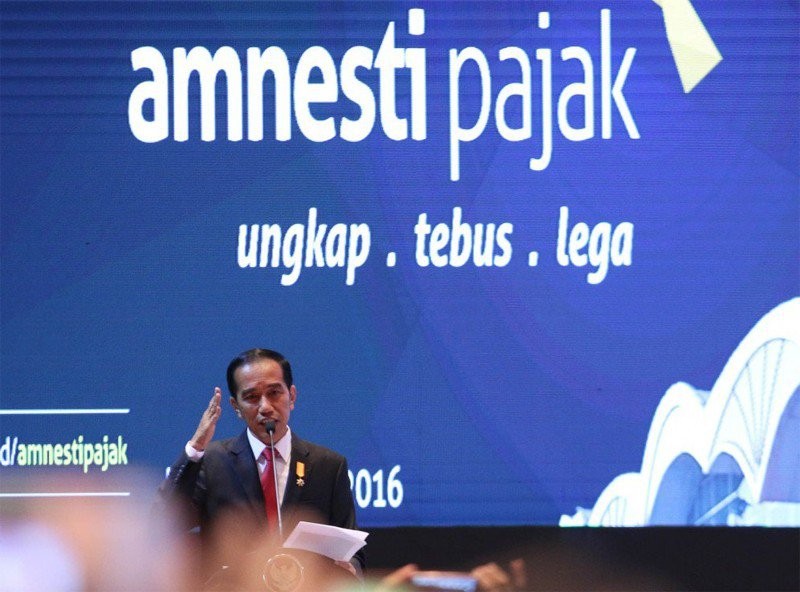Popular Reads
Top Results
Can't find what you're looking for?
View all search resultsPopular Reads
Top Results
Can't find what you're looking for?
View all search resultsReduce spending or raise taxes?
Change text size
Gift Premium Articles
to Anyone
T
he widening state budget deficit has drawn a considerable amount of attention in recent months as the increase in the deficit may force the government to borrow amid the decline in tax revenues.
At the end of June, the budget deficit stood at Rp 231.8 trillion (US$17.58 billion), increasing by Rp 42.7 trillion in only a month.
Along with the domestic economic slowdown and global uncertainty, the government’s revenue shortfall in the current fiscal year is estimated at about Rp 219 trillion.
As a consequence, the finance minister has cut government spending by about Rp 133 trillion.
The government has increased the issuance of bonds to finance the deficit, which has led to an increase in government borrowing, which reached a total of Rp 3.36 quadrillion as of June.
The sharp increase in public debt has highlighted the need for a significant adjustment over the medium term.
The main question is whether the deficit reduction brought about by government spending cuts is really effective in improving the macroeconomic situation.
While most countries in the world implement fiscal stimulus packages as counter-cyclical fiscal policy, the Indonesian government, in contrast, has run a pro-cyclical fiscal policy or a policy that focuses on reducing government spending to cope with a widening deficit.
From a theoretical perspective cuts in public spending are a less popular method of controlling economic fluctuations.
Besides the longer policy lags, the failure of fiscal policies in Latin America during the 1980s and Japan during the 1990s provided negative experiences to fiscal authorities in controlling business cycles.
Basically, spending less is not the only option in reducing state budget deficits. The other alternative is to collect more.
Theoretically, the magnitude of the reduced spending or higher collection will be the same. In its most basic form, the magnitude of the tax (or government expenditure) multiplier depends on the size of the economic actors’ responsiveness.
However, assessing the impact of spending cuts is not easy. The different types of austerity measures produce very different results.
_________________________________
Cuts in public spending are a less popular method of controlling economic fluctuations.
The deficit reductions can lower debt-to-GDP ratios without sparking recessions as long as the spending reduction is combined with deregulation, liberalization of labor markets, and tax reforms.
Conversely, when the fiscal austerity is devoted to maintaining economic stabilization, a spending-based fiscal correction might have mild recessionary effects but will quickly give way to growth.
Any decrease in government spending will affect GDP, even if it has no significant impact on the private sector. On the other hand, the impact of rising tax depends on the type of taxes.
Empirically, the degree of effect of indirect tax on investment, for instance, is insufficient to stimulate economic growth. Meanwhile, an increase in direct tax tends to repress GDP. It seemes that those empirical studies provide mixed evidence on the tax–growth nexus.
This is because they in general estimate the direct impact of an increase in taxes on economic growth.
The channel through which the change in tax policy might affect growth could be analyzed indirectly by connecting it to investment. In this way, tax changes have very large effects on output due to the strong response of investment to the tax burden decrease.
Combining both sides, when governments cut spending, they may signal that tax rates will not have to rise in the future, thus spurring investors (and possibly consumers) to be more active.
It seems that spending cuts and tax rates operate via business confidence since they provide certainty about future fiscal policy, taxation and regulation. Without improving business confidence, cutting spending will result in very small and short-lived recessions.
Accordingly, raising taxes will result in prolonged recessions. Also, the spending-based adjustments cause less contractionary effects than revenue-based adjustments.
Nevertheless, the Nobel laureate Krugman, strongly rejects budget cuts during recessions. He believes that the only way to stimulate the aggregate demand is by increasing government spending rather than reducing it.
Therefore, he suggests spending more to fix the economy especially spending on public investment.
Even though the solution seems simple and effective in isolated recession contexts, this solution has proven to be impossible given that distressed states do not have corresponding fiscal space or reliable financial markets.
In the case of Indonesia, where the fiscal space is still limited and financial markets are not reliable, it is necessary to compromise on spending cuts and tax increases.
First, the spending cuts should be implemented for the unabsorbed budget. The government should boost infrastructure projects and the highest-priority spending programs in regions.
Second, raising tax revenues is not necessarily associated with increasing tax rates. The Indonesian government has a great opportunity to reduce tax rates in order to raise its future revenues. According to the Laffer curve, cutting tax rates would lead to an incline in tax revenues if the optimum tax rates have already been achieved.
For example, a few months ago the finance minister adjusted the personal income tax threshold from Rp 36 million to Rp 54 million. Obviously, this strategy will prompt an increase in household consumer spending. In the end, the increase in consumer spending will generate economic activity overall and therefore tax revenue will be higher.
Third, in line with the above strategy, the corporation tax rate, which is currently 25 percent can be lowered to perhaps 17 percent. The director of taxation said it could even be cut to as low as 10 percent, or equivalent to the value added tax rate.
President Jokowi recently unveiled the possibility of a cut in corporation tax, but without further elaboration.
The implementation of a single income tax rate could improve the competitiveness of Indonesian products in the global market. It also potentially dampens the transfer pricing practices across countries, which have an adverse effect on both fiscal and financial sectors.
As long as the tax amnesty is not accompanied by structural reforms in the real sector, its benefits will be short-term only.
However, both selective government spending cuts and tax revenue increases offer a better precondition for achieving economic growth in the medium term and economic stabilization in the long-run.
__________________________________
The writer is a lecturer at the Faculty of Economics, State University of Jakarta.










